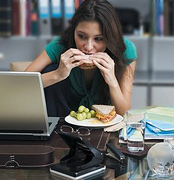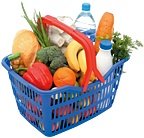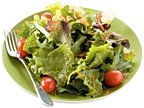Taking Time to Eat Right
By Meghan Vivo
We all crave balance in our lives, but most of us struggle to learn the tricks of the trade. Think of it in terms of the ancient art of juggling: mastered by few, but attempted by many. But you're not just juggling balls - you're attending to the spouse who needs your time and attention; the rambunctious children who need help with all the day's activities; and the demanding job with real-world responsibilities. Where does your health fit in? For far too many of us, it's that one ball we haven't tossed into the air yet. Take heart - you can balance your busy schedule with healthy eating by learning to make quick and nutritious food choices, both at home and on-the-go. AT HOME
 There's no question that the best way to eat fresh, nourishing foods is to cook your own meals at home. That way, you control the ingredients and the way foods are prepared. That's particularly important because it lets you avoid heavily processed foods high in unhealthy trans fats, hydrogenated oils and other additives, which are staples of most fast food and packaged products. Unfortunately, the last thing most people want to do at the end of a busy day is slave over a stove creating a gourmet masterpiece. The good news is, there are a number of ways to make tasty and nourishing meals in less than 20 minutes, if you learn to fully utilize your kitchen.
There's no question that the best way to eat fresh, nourishing foods is to cook your own meals at home. That way, you control the ingredients and the way foods are prepared. That's particularly important because it lets you avoid heavily processed foods high in unhealthy trans fats, hydrogenated oils and other additives, which are staples of most fast food and packaged products. Unfortunately, the last thing most people want to do at the end of a busy day is slave over a stove creating a gourmet masterpiece. The good news is, there are a number of ways to make tasty and nourishing meals in less than 20 minutes, if you learn to fully utilize your kitchen. Shop Wisely Healthy eating starts during your weekly grocery shopping trip. When you shop hungry, the chocolate cake and ready-to-eat fried chicken practically leap into your cart. Your diet for the week is bound to fail with nothing but "treats" in the fridge. To prevent impulse buying, eat before you go grocery shopping and keep a running list throughout the week of the items you need. That way, you'll avoid scanning the aisles for random items - things you might not need, but crave at the time. Also, remember that a meal can consist of fruit and cottage cheese, whole-grain cereal, tuna on whole wheat, or any other combination of light, nutritious foods. You don't have to slave for hours or plan three full courses to call it a meal. What you purchase at the grocery store will affect your eating habits at home and at work. A lot of people have a hard time resisting junk food when it's readily available in the workplace. In reality, the office should be an ideal place for healthy eating because you can pack breakfast, lunch and snacks and limit yourself to those foods. This takes the guesswork out of five days of your week. People inherently gravitate toward easy solutions - you're probably no different. Invest in portable foods like precut and prepackaged fruits and vegetables for quick snacks, and strategically place them in the front of the refrigerator (at home or at work) for easy access. You also can make healthy beverage choices by purchasing bottled water, low-fat milk or 100 percent fruit juice instead of being tempted by the morning coffee or midday soda. Put Your Freezer to Work Your freezer doesn't have to house only ice cream and frozen TV dinners. Although you may have time and energy when the week begins, most people lose motivation to cook healthy meals by the end of the week, and suddenly, you find yourself pulling into the local fast-food joint. To avoid this trend, consider cooking a full week's meals on the weekend and freezing single portions for those hectic weeknights. You also can buy ready-made meals like reduced-sodium canned soups and frozen vegetable mixes. And it only takes a few minutes to cook skinless chicken breasts, brown rice and vegetables. If you need a last-minute dinner idea, grocery stores offer healthy alternatives to fast food, such as prepared salads and rotisserie chicken. Finally, don't be ashamed to utilize your microwave or slow cooker - whatever keeps you home eating a healthy meal.
 Tips for Quick, Healthy Meals at Home
Tips for Quick, Healthy Meals at Home - Cook meals for the entire week in advance and freeze single portions.
- Stock up on quick and easy meals like reduced-sodium soups and frozen vegetable mixes.
- Bring precut and prepackaged fruits and vegetables to work.
- Buy bottled water, low-fat milk or 100 percent fruit juice, rather than coffee and soda.
- Keep a running grocery list to prevent impulse buying.
- Don't grocery shop while hungry; stick to your list.
- Invest in a cookbook with low-fat, low-carb recipe ideas.
ON-THE-GO Eating consistently healthy meals at home can be a chore; hence the appeal of fast food, which is quick and convenient, and one of the few things you can still buy for under $5. But things have gotten out of control: In 1972, the U.S. spent $3 billion on fast food; today, we spend more than $110 billion annually. How do they make fast food so fast? In many cases, it's because you're buying low-quality, highly processed foods. A 15-year study has shown a strong link between fast food, obesity and insulin resistance. Study participants who ate fast food more than twice a week were more likely to develop obesity and type 2 diabetes. With 60 percent of all Americans either overweight or obese, there is obvious reason to limit your intake of fast food, if not avoid it altogether. But when life gets unmanageable, the convenience of fast food can be irresistible for even the most disciplined. On those days, follow these tips to make sensible fast-food choices. Do Your Research Which fast food is healthier: a salad with ranch dressing or a fish sandwich? While fish in general is an excellent choice, fast-food fish is usually fried, and fried anything should not be on your diet plan. A salad also has great health potential, but if it is soaked in dressing, you may as well eat a bacon cheeseburger. Why don't people make better choices? In part, people do not have the information they need to make healthy choices. But the information is out there. You can get a break-down of fat, calories and other nutritional information on just about every fast-food item by visiting one of the dozens of Web sites dedicated to educating the public. You also can buy a restaurant and fast-food nutrition guide and carry it with you. For example, the Calorie, Fat and Carbohydrate Counter, produced by the company Calories King, provides the following eye-opening facts: - A large fry has 540 calories and 26 grams of fat, but a small fry has about 60 percent less fat and calories (210 calories and 10 grams of fat).
- A milkshake can have up to 1,000 calories.
- A large (32-ounce) soda has about 400 calories and 30 teaspoons of sugar.
- An order of chicken nachos has more than 2,000 calories.
- A typical burger has around 700 calories and 39 grams of fat.
- A piece of chocolate chip cookie dough cheesecake has almost 2,000 calories and 72 grams of fat.
- Some cinnamon rolls have more than 1,000 calories and 56 grams of fat. And that's just your breakfast!
- One fried chicken breast has almost 500 total calories.
By some estimates, you would have to walk for seven hours straight to burn off the typical fast-food chain's large "combo meal" with soda, fries and a burger. Think of the upside: If you choose healthy foods, you can "super-size" without the guilt. Resist Taste-Bud Temptations Consumers spent a whopping $476 billion eating out in 2005, nearly 5 percent more than in 2004, and spending continues to rise. Is this simply a matter of convenience? The fact is the demand for tasty food drives the fast-food industry to produce high-fat, high-calorie foods. We as consumers have to take responsibility and start listening to our minds, rather than our taste buds. According to USA Today, Burger King sells around 100 Whoppers for every Veggie Burger it sells, and about 10 Whoppers for every salad. Sadly, fast food junkies prefer fried chicken sandwiches 10 to 1 over grilled chicken. Most fast-food chains conduct heavy consumer testing, and the people have spoken: The greasier, the better. Some burger chains have gone so far as to plant real people at the drive-through order board to further expedite the handling of your order. Restaurant chains now have special "preferred" parking spaces with dutiful employees running out to deliver your food as you drive up. The problem is that it reinforces a culture of taking the easy way out, both in terms of the food we choose and how much we have to move to get it. The Centers for Disease Control estimates that the average family spends 40 percent of its food budget on fast food. Even though fast food is a fact of life for most, there are still ways to make healthy choices when you're on-the-go. For example, when ordering pizza, load it with veggies instead of meat, and request light cheese. An easy way to incorporate more fruits and veggies is to leave the lettuce and tomato on sandwiches or burgers. While combo meals offer excellent value, the calories are off the charts. Instead, consider ordering a salad with light dressing on the side, a chicken sandwich or even a kid's meal. Be sure to skip the extras like mayonnaise, special dressings, croutons, cheese and bacon, and milkshakes. This way, you can still enjoy your food in a hurry, without the hundreds of additional calories. Restaurant Dangers After a long work week, you deserve a treat, right? Many people treat themselves to a nice dinner on the town at least one night a week. Approximately 47 percent of the money Americans spent on food in 2005 was spent at restaurants as compared to 25 percent in 1955, according to the National Restaurant Association. If you're trying to eat healthy, decadent restaurant meals can challenge your will power. But there are nutritious options if you know what to look for. If you show up at the restaurant starving, chances are you'll devour the basket of bread on the table before your meal arrives. Skip the bread, or at least try a whole-wheat variety. If you order a salad, request the dressing on the side, and use it sparingly. Even when you think you're being healthy by ordering a grilled chicken sandwich, a sneak peek behind the scenes will reveal that a surprising number of chefs douse meats, rolls and even vegetables in butter. Why do you think restaurant food tastes so much better than old-fashioned home cooking? Be sure to ask your waiter for "no butter added" on your entrée, especially vegetables. Most importantly, restaurants often attract customers with gigantic portion sizes so you feel you're getting your money's worth. Given this reality, consider ordering a lunch portion, if possible, or saving half of your meal for the next day. The Bright Side Supply follows demand. Now that the American public is expressing interest in healthier fast-food options - not just offering lip service, but actually spending its hard-earned money - fast-food restaurants are increasingly offering burger and fry alternatives like salads, grilled chicken sandwiches, fruit and yogurt. But no one is going to force-feed you fruits and vegetables. Fast-food companies now offer a wide range of options and leave it to you to "do the right thing." It won't be easy. The commercials don't glamorize salad and fruit as frequently as they do the latest 2-pound burger slathered in sauce, bacon and cheese. And of course, your hectic life's probably not going to get any less hectic anytime soon. We all have responsibilities to juggle. Healthy eating is just one more ball to juggle, but it's one of the most important ones. Now that you know the keys to sensible eating - at home and on-the-go - you've already taken the first step toward achieving a more balanced life.
 Tips for Quick, Healthy Meals On-the-Go
Tips for Quick, Healthy Meals On-the-Go - Always choose grilled over fried - less oil = less fat and calories.
- Order a salad and ask for low-fat dressing on the side.
- Skip the extras: mayonnaise, dressings, croutons, cheese and bacon, milkshakes.
- Share with a friend - you can still have a couple of French fries or onion rings without eating the entire box.
- Forget the bun on your burger, or eat only half of the bun.
- Choose a kid's meal over combo meals and "super-size" items. Believe it or not, kid's meals usually have plenty of food for the average adult.
- Choose fruit salad or low-fat ice cream for dessert rather than pies, cookies or turnovers.
Page printed from:
http://www.toyourhealth.com/mpacms/tyh/article.php?id=906&no_paginate=true&no_b=true
|

